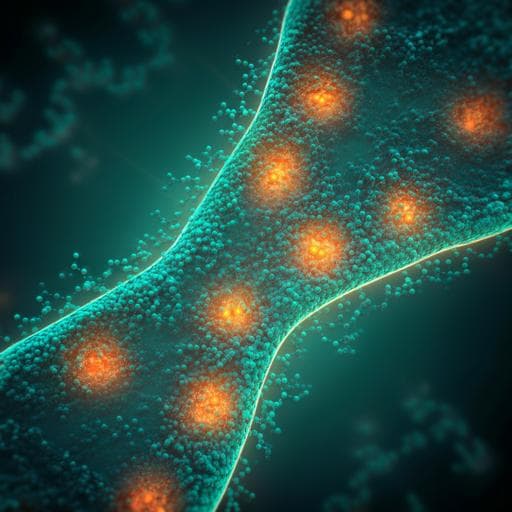
Medicine and Health
Orally desensitized mast cells form a regulatory network with Treg cells for the control of food allergy
Y. Takasato, Y. Kurashima, et al.
Discover how oral immunotherapy (OIT) can transform the management of food allergies! This research by Yoshihiro Takasato and colleagues reveals that desensitized mast cells enhance regulatory T cell expansion, paving the way for innovative therapeutic strategies against allergic diseases.
~3 min • Beginner • English
Introduction
The study addresses how oral immunotherapy (OIT) controls food allergy by uncovering the cellular and molecular mechanisms during the transition from desensitization to long-term regulation. Food allergy involves mast cell (MC) activation via IgE-FcεRI, leading to mediator release, intestinal permeability, diarrhea, and risk of anaphylaxis. Conventional therapies target MC degranulation or mediators, and MC-derived Th2 cytokines (notably IL-4) amplify allergic responses. While OIT (dose escalation followed by maintenance) is clinically effective, mechanistic understanding—particularly within gut mucosa—is limited, as prior work often focuses on basophil markers in blood. The authors hypothesize that OIT reprograms intestinal MCs from pathogenic to regulatory states, promoting regulatory T cell (Treg) expansion and clinical unresponsiveness, and seek to define the MC–Treg network and requirements for maintenance of desensitization.
Literature Review
Prior studies show allergen-specific immunotherapy (subcutaneous/sublingual) reduces allergic disease, and OIT can control food allergy but with unclear long-term mechanisms. MCs drive pathology via degranulation and Th2 cytokines (IL-4, IL-5); increased intestinal MCs correlate with food allergic diarrhea. MCs can exhibit immunomodulatory functions producing IL-2 and IL-10 in various contexts (dermatitis, asthma, graft-versus-host disease). Treg and Tr1 cells are implicated in oral tolerance, with tolerogenic dendritic cells supporting peripheral Treg induction. IgG–FcγRIIb signaling can suppress MC activation and promote tolerance in food allergy models. IL-33 can induce MC IL-2 in airway/skin models, though it promotes food anaphylaxis in epicutaneous sensitization. Technical/ethical limits in human mucosal studies motivate murine OIT models to explore local mechanisms.
Methodology
Design: Development of a clinically relevant murine OIT model mimicking escalation and maintenance phases to interrogate MC and Treg dynamics in gut mucosa during control of food allergy.
- Animals: Female BALB/c mice; MC-deficient strains KitW-sh/W-sh and Mas-TRECK (DT-inducible MC depletion); IL-33- and ST2-deficient mice on BALB/c background. Specific-pathogen-free housing; institutional approvals obtained.
- Food allergy induction: Mice presensitized with 1 mg ovalbumin (OVA) in complete Freund’s adjuvant by subcutaneous injection; after 1 week, orally challenged 3×/week with 50 mg OVA for several weeks to induce allergic diarrhea. Mice with confirmed diarrhea upon 25 mg raw OVA challenge were enrolled as “allergy group.”
- OIT protocol: Dose-escalation of heated OVA: 0.5, 1, 2, 4, 8, 12, 18, 25 mg daily (days 1–8), followed by maintenance with 25 mg unheated OVA daily (up to day 36). Comparison of continued versus stopped maintenance after induction. Severity of diarrhea graded by stool appearance and fecal water content (drying method with silica gel, 5-day endpoint).
- MC involvement: MC-deficient KitW-sh/W-sh and Mas-TRECK mice tested for allergic diarrhea upon OVA challenge; in Mas-TRECK, DT administration controlled MC depletion and reconstitution. Serum mouse mast cell protease-1 (mMCP-1) quantified by ELISA as MC activation marker. Flow cytometry of intestinal lamina propria MCs (CD45+ c-kit+ FcεRIα+) for CD63 (degranulation marker) and frequency; degranulated MCs quantified. MC IL-4 expression assessed by qRT-PCR from sorted MCs. ChIP and ChIP-Seq on MCs for H3K27Ac at IL-4/IL-13 loci to assess epigenetic changes.
- T cell analyses: Foxp3+ Tregs (CD45+ CD4+ Foxp3+) quantified by flow cytometry in colon, blood, spleen, mesenteric lymph nodes; Tr1 cells (CD4+ CD49b+ CD223+) enumerated. Functional depletion of Tregs via anti-CD25 monoclonal antibody (PC61; 250 µg i.p. on days 9, 13, 17, 20). OVA-specific IgE measured by ELISA.
- Role of MCs in Treg induction: MC depletion during OIT in Mas-TRECK mice (DT days 5–36), followed by analysis of intestinal Treg frequency and cytokine expression (IL-10, TGF-β) in CD25+ CD39+ CD103+ CD4+ T cells (qRT-PCR). Dendritic cell subset profiling (Tim4+ CD11c+ and CD103 CD11bneg CD11c+) to assess tolerogenic DC changes.
- In vitro MC desensitization and coculture: Bone marrow–derived MCs (BMMCs; ~95% purity), sensitized with anti-DNP IgE (0.25 µg/mL), then subjected to rapid antigen desensitization via stepwise DNP-HSA additions every 10 min (50 pg to 17.5 ng total), followed by stimulation (80 ng, 1 h). Degranulation assessed by surface CD63 and β-hexosaminidase release. MC IL-4 expression quantified by qRT-PCR. Cocultures: IgE-bound control, antigen-activated, or desensitized BMMCs with CD4+ T cells (from spleen/MLN; 8×10^5) for 3 days; plates pre-coated with anti-CD38; Treg expansion (Foxp3) measured by flow cytometry. Transwell assays to test soluble factor mediation. MHC-II and co-stimulatory molecule expression on MCs assessed (Supplementary data).
- Cytokine profiling: Gene expression microarray and qRT-PCR on activated vs desensitized MCs; cytokines tested included IL-2, IL-6, IL-11, IL-17d. Cytokine production measured by ELISA, focusing on IL-2. Neutralization of IL-2 with anti-IL-2 antibody in cocultures to test dependence of Treg expansion.
- Human MC studies: Human peripheral blood CD34+ derived MCs generated in culture; IgE/NP-BSA–based desensitization protocol analogous to mouse; IL-2 in supernatants measured by high-sensitivity ELISA.
- Statistics: Unpaired two-tailed Student’s t test; P < 0.05 significant; data shown as mean ± SEM.
Key Findings
- MCs are essential for allergic diarrhea: MC-deficient KitW-sh/W-sh and Mas-TRECK mice did not develop OVA-induced allergic diarrhea; reappearance of diarrhea occurred after MC reconstitution in Mas-TRECK upon stopping DT.
- OIT efficacy and MC desensitization: Dose-escalation OIT reduced watery diarrhea; ~70% of OIT mice showed no stool change vs >80% soft/liquid in allergy controls. Colonic MC percentage decreased in OIT vs allergy (P < 0.05) yet remained above intact levels. Serum mMCP-1 was significantly lower in OIT (P < 0.01). CD63 expression and frequency of degranulated MCs normalized to near-intact levels in OIT. MC IL-4 expression was significantly reduced in OIT vs allergy.
- Maintenance requirement: Stopping maintenance OVA after initial OIT led to recurrence of diarrhea and increased CD63+ degranulated MCs; continued OVA maintained desensitization and clinical protection.
- Regulatory T cells: Tr1 cell numbers were unchanged by OIT, but Foxp3+ Tregs significantly increased with OIT; stopping OVA reduced Tregs. Anti-CD25 treatment during OIT depleted Tregs and caused recurrence of diarrhea and elevated OVA-specific IgE, indicating Tregs are required for OIT-mediated control.
- DC subsets: Proportions of Tim4+ CD11c+ and CD103 CD11bneg CD11c+ DCs were not significantly altered by OIT, suggesting DC composition changes were not the primary driver.
- MC–Treg linkage: MC depletion during OIT (Mas-TRECK + DT) significantly reduced intestinal Treg frequency (P < 0.01) without affecting spleen/MLN Tregs and decreased inhibitory cytokine expression (IL-10, TGF-β) in Tregs, indicating OIT-induced MCs promote Treg expansion/quality locally.
- In vitro desensitization reprograms MCs: Desensitized BMMCs showed reduced CD63 upregulation and β-hexosaminidase release vs activated controls; IL-4 expression decreased. ChIP-Seq showed reduced H3K27Ac at IL-4 and IL-13 promoters in desensitized vs activated MCs, consistent with epigenetic repression of Th2 cytokines.
- Desensitized MCs expand Tregs via soluble IL-2: In coculture, only desensitized MCs expanded Foxp3+ CD4+ T cells; transwell separation preserved expansion, implicating secreted factors. Gene profiling and assays identified increased IL-2 production (but not IL-6, IL-11, IL-17d) by desensitized MCs. Anti-IL-2 neutralization markedly inhibited Treg induction. Human desensitized MCs showed a trend toward increased IL-2 secretion (P = 0.145). In vivo, intestinal lamina propria MCs from OIT mice had elevated IL-2 and IL-10 expression (P < 0.05).
- IL-33 independence: IL-33/ST2 deficiency did not abolish Treg induction by desensitized MCs, indicating an IL-2–dependent, IL-33–independent mechanism.
Discussion
The study demonstrates that OIT converts intestinal mast cells from a pathogenic, Th2-prone state to a desensitized regulatory phenotype. This reprogramming reduces degranulation and IL-4 output while inducing IL-2 (and in vivo IL-10), which together support expansion and function of Foxp3+ Tregs that suppress allergic diarrhea and reduce allergen-specific IgE. The requirement for continuous allergen exposure underscores that maintenance dosing sustains MC desensitization and the Treg network. MC depletion specifically during OIT reduced intestinal Tregs and their inhibitory cytokines, highlighting that desensitized MCs are pivotal local drivers of Treg-mediated tolerance rather than changes in dendritic cell subset proportions. In vitro desensitization recapitulated the functional and epigenetic shift in MCs, and coculture experiments identified soluble IL-2 as necessary for Treg expansion. These findings mechanistically link clinical OIT efficacy to an MC–Treg regulatory circuit within gut mucosa and suggest that targeting MC reprogramming could generalize to control of allergic inflammation beyond food allergy.
Conclusion
This work establishes that dose-escalation OIT induces desensitized regulatory mast cells in the intestinal mucosa, which secrete IL-2 (and in vivo IL-10), repress Th2 cytokines, and expand Foxp3+ Tregs to achieve clinical unresponsiveness to food allergens. Continuous allergen exposure is required to maintain this desensitized state and protection. The study uncovers an IL-2–dependent, IL-33–independent MC–Treg axis as a core mechanism of OIT and provides epigenetic evidence for MC reprogramming at IL-4/IL-13 loci. Future research should: (1) delineate upstream signaling and transcriptional pathways that drive IL-2/IL-10 induction during MC desensitization; (2) define how IgG–FcγR pathways contribute to MC regulatory functions in OIT; (3) validate and quantify regulatory MC signatures and Treg expansion in human OIT cohorts; and (4) develop strategies or adjuvants that selectively induce regulatory MCs to enhance OIT efficacy and durability.
Limitations
- Translation: Findings are primarily in murine models; human validation was limited to in vitro IL-2 trends in MCs, without in vivo confirmation of the full MC–Treg pathway.
- Mechanistic depth: The molecular signaling leading to IL-2 (and IL-10 in vivo) induction in desensitized MCs remains incompletely defined; epigenetic analyses focused on IL-4/IL-13 and did not comprehensively map regulatory cytokine loci.
- In vitro vs in vivo discrepancy: IL-10 upregulation was observed in vivo in intestinal MCs but not in in vitro–desensitized MCs, suggesting context-dependent cues (e.g., IgG–FcγR signaling, microenvironmental factors) are required.
- Maintenance dependency: Protection wanes when OIT is stopped; durability of tolerance and mechanisms sustaining long-term unresponsiveness beyond continuous exposure were not resolved.
- DC involvement: While DC subset proportions were unchanged, functional properties of DCs were not exhaustively tested and could still contribute.
- Statistical power: Some human MC IL-2 data showed only a trend (P = 0.145), indicating limited sample size/power.
Related Publications
Explore these studies to deepen your understanding of the subject.







